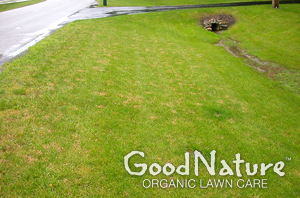 Loading... Please wait...
Loading... Please wait...Categories
Popular Brands
Our Newsletter
Pink Patch
What is Pink Patch?
Pink Patch is a fungal organism that causes patches of turf to turn brown and produce a pink fuzz cotton candy-like material. It can be unsightly, but in most cases, the grass will recover just fine when the temperature cools in the fall.
Why do you have Pink Patch?
It is normal for lawns to get a mild dose of Pink Patch when conditions are optimal. Pink Patch is really a symptom of one or more of the following: improper watering, poor grass, poor soil or all of the above:
Improper Watering
The fungus thrives when the surface of the soil lawn is wet and the roots are dry. Also, watering too often will cause the disease to get worse.
Solution to Improper Watering
Don’t water more than every 3-4 days and make sure to water in the morning or early afternoon...onlyso the grass does not stay wet all night. Water on the blades will cause Pink Patch to get worse. Also, one or more liquid aeration treatments will help the water move down into the soil and can make the disease less severe.
Poor Grass
Pink Patch is most severe on Perennial Ryegrass...which is susceptible to a lot of diseases (Rust, Dollar Spot, Red Thread etc.). Builders and landscapers plant a lot of Perennial Ryegrass because it sprouts quickly. Homeowners often buy a Perennial Ryegrass/Kentucky Bluegrass blend and seed it at a heavier rate than the manufacturer recommends. If a little is good, a lot is better. Right? Wonrg...the ryegrass takes over because it comes up faster than the bluegrass. So even though they planted a blue/rye mix, they end up with a ryegrass lawn that is susceptible to Pink Patch, rust, dollar spot, red thread etc.
Solution to Poor Grass
If you have a lawn that is predominately Perennial Ryegrass, Pink Patch and other diseases will always be a problem. We highly recommend Super Seeding in the late summer to get some different more resistant types of grass in your lawn.
Poor Soil
Newer lawns typically don’t have the most biologically active soil and because of that are subject to disease issues. The more biologically active your soil is, the fewer problems your lawn will have.
Solution to Poor Soil
Fertilizing organically will gradually build soil biology and improve your soil and your lawns disease resistance. If you’d like to speed the process you might want to consider a Compost Topdressing, Liquid Aeration, and/or Core Aeration.
What can you do now about Pink Patch?
To help protect your lawn from Pink Patch we recommend:
- Don't water more than every 3-4 days...only in the morning or early afternoon
- Clean your mower between mowing...bag clippings for awhile if Pink Patch is severe
- Feed your lawn organically (so you don’t kill off the good soil organisms that fight disease causing fungi)
- Add resistant grasses (Super Seeding can really help)
- Minimize your thatch layer (Liquid Aeration in Spring and Core Aeration in the fall)
- Topdress with compost in the fall to add beneficial biology





